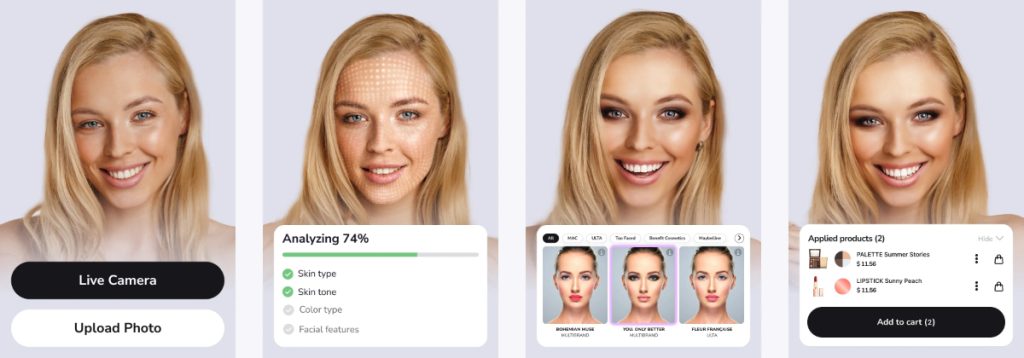
Do you remember the days when we used social media only for sharing photos, writing our thoughts, or just chatting with friends? It seems like it was a lifetime ago! But today, we live in the times when platforms like Instagram or TikTok offer way more than simply sharing what’s going on in our lives. They have transformed into places where we can add a digital crown to our faces, turn our background into a tropical island, create an avatar that’ll represent our persona in the virtual world, and beyond—all from our phones. This is possible due to the development of augmented reality (AR), the tech that has turned social media from simple communication to immersive digital interaction.
But how did we get here, and where is AR taking us next? Let’s explore how filters, avatars, and virtual worlds are reshaping the way we communicate and connect online.
AR Filters – The Birth of Digital Self-Expression
Filters are probably one of the earliest and most well-known uses of AR on social media. If you’ve ever spent even five minutes on Snapchat or Instagram, you might have tried at least some of them. Remember the dog filter craze? Or the countless face-swapping memes? What started as fun, light-hearted ways to play around with your appearance has evolved into something much bigger.
How do they work? AR filters use your smartphone’s camera to overlay digital elements onto your real-world image. Despite sounding pretty simple, the result is magical: out of a sudden, you aren’t just sharing photos but creating something truly interactive and dynamic. Want to make your face look like a painting? Here you are! Want to try on virtual makeup in a makeup simulator online? Here you are again!
What makes AR filters particularly beautiful is their accessibility. Anyone with a smartphone can use them, and users are no longer just passive consumers—they’re active creators. Social media platforms encourage people to make their own AR filters, contributing to a growing library of effects that cater to every mood, event, and trend.
Beyond fun and games, AR filters have become an effective tool for businesses. Numerous brands are using them to make their interaction with customers even more engaging. Take Nike or IKEA, for example, Nike is using AR to let customers try on their shoes before making the final purchase, while IKEA allows them to see how any piece of furniture will look in their room. This way, brands reach consumers directly, making the shopping process both more interactive and personalized.
Avatars – The Digital You
If AR filters let you play with your appearance, avatars take it a step further by allowing you to create an entirely new digital version of yourself. Whether it’s through Snapchat’s Bitmoji or the customizable avatars you can build on Facebook, these animated figures are becoming a bigger part of how we represent ourselves online.
Avatars are fun because they offer a new way to communicate online. Instead of just sending a plain text, you can send a Bitmoji of your avatar high-fiving, sipping coffee, or even dancing. These little digital characters help inject personality into your online interactions, giving your messages a personal touch that plain old text can’t provide.
But of course, AR avatars are not only for fun. With the rise of virtual worlds and metaverses, like Meta’s Horizon Worlds or VRChat, these avatars have every chance to become our main way of interacting with others in this huge social media world.
Virtual Worlds – Building New Social Spaces
No doubt that filters and avatars are cool, but the true power of AR lies in its ability to create virtual worlds. And here, we don’t mean simply editing your background with some React Native video editor, no! We’re talking about visiting a concert, going to a new city, attending a museum, or even hanging out with friends in some digital space—all from the comfort of your home. This is where AR is heading, transforming social media into a platform for shared, augmented experiences.
And things are moving in this direction with a growing speed! Companies are heavily investing in the metaverse—a collection of virtual worlds connected with one another and letting people socialize and work there. And AR is likely to play a very important part in its development as well. The reason is that AR adds an additional interactive layer that’s so important for mixing the two worlds: digital and physical. Just imagine meeting with friends in a virtual replica of your favorite restaurant or visiting a live event where digital avatars perform alongside real-world artists.
AR and the Future of Social Media
AR isn’t just a fun feature anymore—it’s transforming the very way we experience social media. From playful filters that let us experiment with our looks to avatars that represent our digital selves, AR is giving us new ways to express ourselves, engage with others, and explore digital spaces.
AR tech keeps advancing, and now it’s clearer than ever that social media is likely to evolve from a 2D experience into a 3D augmented space. Instead of just scrolling through feeds, we could shortly find ourselves in digital worlds where we can interact with our holographic friends, blurring the line between our physical and virtual selves. AR is not just changing how we use social media—it’s reshaping the very fabric of our digital lives.
So the next time you snap a selfie with a puking rainbow filter or send a Bitmoji to a friend, remember—you’re part of a digital revolution that’s changing the way we see the world, both online and offline.

























































